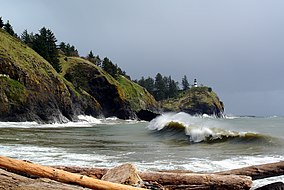
Summary
Cape Disappointment State Park (formerly Fort Canby State Park) is a public recreation area on Cape Disappointment, located southwest of Ilwaco, Washington, on the bottom end of Long Beach Peninsula, the northern headlands where the Columbia River meets the Pacific Ocean. The state park's 2,023 acres (819 ha) encompass a diverse landscape of old-growth forest, freshwater lakes, freshwater and saltwater marshes, and oceanside tidelands. Park sites include Fort Canby, the Lewis and Clark Interpretive Center, North Head Lighthouse, and Cape Disappointment Lighthouse.[2] Cape Disappointment is one of several state parks and sites in Washington and Oregon that are included in Lewis and Clark National Historical Park.[3]
| Cape Disappointment State Park | |
|---|---|
 South end of Cape Disappointment and its lighthouse | |
 Location in the state of Washington  Cape Disappointment State Park (the United States) | |
| Location | Pacific County, Washington, United States |
| Coordinates | 46°17′28″N 124°04′20″W / 46.29111°N 124.07222°W[1] |
| Area | 2,023 acres (8.19 km2) |
| Elevation | 20 ft (6.1 m)[1] |
| Established | Early 1950s |
| Operator | Washington State Parks and Recreation Commission |
| Website | Cape Disappointment State Park |
History edit
Cape Disappointment earned its name when Captain John Meares failed to cross the river bar in 1788. The feat was accomplished in 1792 by American Captain Robert Gray. The Lewis and Clark Expedition arrived at Cape Disappointment in 1805.[2]
In 1862, during the American Civil War, a camp called Post at Cape Disappointment was established and fortifications existed here from that date to protect the northern approaches to the mouth of the Columbia River from possible attacks by Confederate raiders or foreign fleets. It was garrisoned by Company A, U.S. 9th Infantry Regiment and Company A, 8th Regiment California Volunteer Infantry in the District of Oregon. In 1863, its mate Fort Stevens was established on the south bank of the Columbia River. In 1864, the post was renamed Fort Cape Disappointment. Some Civil War-era fortifications still exist: the Tower (or Right) Battery, Left Battery, and Center Battery.
Fort Cape Disappointment was expanded and renamed Fort Canby in 1875. By 1906, when construction finished under the Endicott program, Fort Canby became part of the three-fort Harbor Defenses of the Columbia River as a subpost of Fort Stevens along with Fort Columbia.[4] The fort was further expanded during World War II. After being decommissioned in the years following World War II, the fort was turned over to the state for use as a state park in the early 1950s.[5] Workers with the Civilian Conservation Corps helped restore the fort and improved roads and trails during the 1930s.[2]
Facilities edit
The Lewis and Clark Interpretive Center sits on a cliff that overlooks the confluence of the Columbia River and the Pacific Ocean. There are exhibits about the 1803–1806 Lewis and Clark Expedition from St. Louis, Missouri to the Pacific coast, the park's later history, including the lighthouses, U.S. Coast Guard and military activities, and the area's maritime and natural history.[6]
Activities and amenities edit
Cape Disappointment State Park offers camping and other overnight accommodations, eight miles (13 km) of hiking trails, stands of old-growth Sitka spruce,[7] watercraft launch sites, picnicking facilities, and tours of the North Head Lighthouse.[2]
Many of the WWII-era military facilities still exist in a ruined state throughout the park and are accessible to the public.
Cape Disappointment State Park’s camping facilities include standard campsites, full hookup RV sites, yurts, cabins, and historic vacation homes. Camp facilities include full-service restrooms with showers and a park store nearby for groceries, wood, and a café.[8]
References edit
- ^ a b "Cape Disappointment State Park". Geographic Names Information System. United States Geological Survey, United States Department of the Interior.
- ^ a b c d "Cape Disappointment State Park". Washington State Parks and Recreation Commission. Retrieved February 16, 2016.
- ^ "Lewis & Clark National Historical Park". National Park Service. Retrieved February 16, 2016.
- ^ "Fort Canby". Coast Defense Study Group. Retrieved November 2, 2018.
- ^ Tate, Cassandra (January 9, 2006). "Cape Disappointment State Park". The Online Encyclopedia of Washington State History. HistoryLink. Retrieved February 16, 2016.
- ^ "Lewis & Clark Interpretive Center". Washington State Parks and Recreation Commission. Retrieved February 16, 2016.
- ^ "Coastal Forest Loop Hike - Hiking in Portland, Oregon and Washington". www.oregonhikers.org. Retrieved May 6, 2021.
- ^ "Cape Disappointment State Park | Washington State Parks and Recreation Commission".
External links edit
- Cape Disappointment State Park Washington State Parks and Recreation Commission
- Cape Disappointment State Park Map Washington State Parks and Recreation Commission


